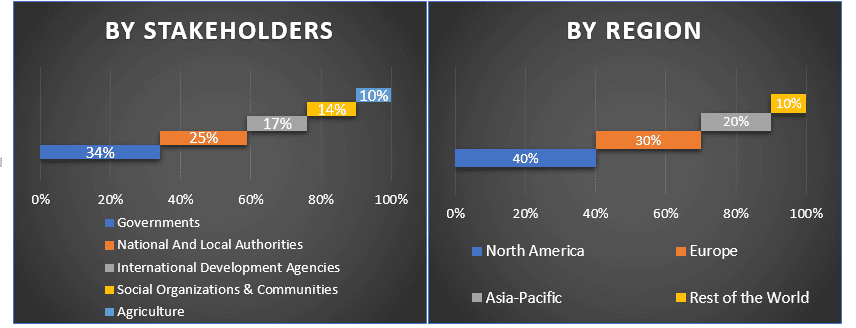- Home
- About Us
- Industry
- Services
- Reading
- Contact Us
Rainwater Harvesting Market: Current Analysis and Forecast (2021-2027)
Harvesting Method (Above Ground, Below Ground); Application (Commercial, Industrial, Residential, Agricultural); Region and Country

Rainwater Harvesting Market is expected to exceed the market valuation of more than US$ XX billion in 2027 and is expected to grow at a significant CAGR of XX% during the forecast period (2021-2027). Rainwater harvesting is collecting the run-off from a structure or other impervious surface in order to store it for later use. Traditionally, this involves harvesting the rain from a roof. The rain will collect in gutters that channel the water into downspouts and then into some sort of storage vessel. Rainwater collection systems can be as simple as collecting rain in a rain barrel or as elaborate as harvesting rainwater into large cisterns to supply your entire household demand.
Rainwater harvesting is becoming a viable alternative for supplying our households and businesses with water. There are many countries such as Germany and Australia where rainwater harvesting is a norm. With growing awareness regarding green building movement, rainwater harvesting systems is expected to significant adoption in coming years.
The collection of rainwater is known by many names throughout the world. It ranges from rainwater collection to rainwater harvesting to rainwater catchment. In addition, terms such as roof water collection or rooftop water collection is also used in other countries
Rainwater harvesting is a viable technology in an urban setting. All that is necessary to take advantage of this resource is to capture the free water falling from the roof and direct it to a rainwater storage tank. By doing this, one can take control of your water supply and replace all or at least a substantial portion of their water needs. Rainwater harvesting systems can be configured to supply the whole house and/or any landscape.
The global rainwater harvesting market is driven by the rapidly increasing global population. This has led to an intensification of the pressure on natural water resources. Consequently, consumers are shifting from natural water resources to the storage of water via various effective means, such as rainwater harvesting, to keep the depletion of groundwater level under check. Moreover, due to the minimum maintenance, easy installation process, and availability in a wide range of tank sizes and types, rainwater harvesting is becoming one of the most popular and adopted water harvesting mechanisms across the globe. Further, governments of several countries are promoting campaigns and initiatives to encourage the adoption of rainwater harvesting in both domestic as well as industrial sectors. They are also offering tax relaxations and incentives to encourage the use of these systems.; for example, the Government of India’s investments into the construction of numerous rainwater harvesting structures in the rural and urban areas of the country, which is expected to assist in an equal distribution of and accessibility to drinking water. Decreasing fresh water is expected to accelerate the industry in the forecast period.
Commercial General Usage of Stored Water (%)

Kingspan Group Plc., Watts Water Technologies, Inc., Otto Graf Gmbh Kunststofferzeugnisse, WISY AG, Innovative Water Solutions LLC, D&D Ecotech Services, Rain Harvesting Supplies, Inc., Water Field Technologies Pvt. Ltd., Stormsaver Ltd., and Climate Inc. are some of the prominent players operating in the Rainwater Harvesting market. Several M&As along with partnerships have been undertaken by these players to facilitate customers with hi-tech and innovative products/technologies.
Insights Presented in the Report
“Amongst Harvesting Method, Above Ground segment holds the major share”
Based on Harvesting Method, the Rainwater Harvesting Market is segmented into Above Ground and Below Ground. Above Ground is further segmented into Storage Tank and Ground Surface. Above ground garden rainwater systems allow you to store water in your garden without the need for a big project to install a tank underground. Above ground systems will take up space in your garden, but with a selection of sizes available – from 800 to 4000 litres – there are tanks to fit nearly every outdoor space.
“Amongst Application, Agricultural segment holds the major share”
Based on Application, the Rainwater Harvesting Market is segmented into Commercial, Industrial, Residential, and Agricultural. Rainwater harvesting has agricultural uses. It can be used for watering gardens in our homes and crop plants in agricultural fields. If a patch of land, say of 100 hectares, is treated for rainwater harvesting, this area would have 5 hectare of water bodies and each farmer would have free access and full control over water they require. These reduce the reliance of garden owners and farmers on other sources of water supply, thus saving them money. Furthermore, the use of soft water from rainwater harvesting can help to reduce farmers operating costs.
“North America represents one of the largest markets of Rainwater Harvesting market”
For a better understanding of the market dynamics of the Rainwater Harvesting market, a detailed analysis was conducted for different regions across the world including North America (US, Canada, Rest of North America), Europe (Germany, UK, France, Spain, Italy, Rest of Europe), Asia-Pacific (China, Japan, India, Australia, Rest of Asia-Pacific), Rest of World. North America dominated the market and grabbed around XX% market share owing to increasing penetration of internet in the region.
Reasons to buy this report:
- The study includes market sizing and forecasting analysis validated by authenticated key industry experts
- The report presents a quick review of overall industry performance at one glance
- The report covers an in-depth analysis of prominent industry peers with a primary focus on key business financials, product portfolio, expansion strategies, and recent developments
- Detailed examination of drivers, restraints, key trends, and opportunities prevailing in the industry
- The study comprehensively covers the market across different segments
- Deep dive regional level analysis of the industry
Customization Options:
Rainwater Harvesting market can further be customized as per the requirement or any other market segment. Besides this, UMI understands that you may have your own business needs, hence feel free to connect with us to get a report that completely suits your requirements.
Table of Content
Analyzing the historical market, estimation of the current market, and forecasting the future market of the Rainwater Harvesting market were the three major steps undertaken to create and analyze the adoption of Rainwater Harvesting in major regions globally. Exhaustive secondary research was conducted to collect the historical market numbers and estimate the current market size. Secondly, to validate these insights, numerous findings and assumptions were taken into consideration. Moreover, exhaustive primary interviews were also conducted, with industry experts across the value chain of the Rainwater Harvesting market. Post assumption and validation of market numbers through primary interviews, we employed a top-down/bottom-up approach to forecasting the complete market size. Thereafter, market breakdown and data triangulation methods were adopted to estimate and analyze the market size of segments and sub-segments the industry pertains to. Detailed methodology is explained below:
Analysis of Historical Market Size
Step 1: In-Depth Study of Secondary Sources:
Detail secondary study was conducted to obtain the historical market size of the Rainwater Harvesting through company internal sources such as annual report & financial statements, performance presentations, press releases, etc., and external sources including journals, news & articles, government publications, competitor publications, sector reports, third-party database, and other credible publications.
Step 2: Market Segmentation:
After obtaining the historical market size of the Rainwater Harvesting market, we conducted a detailed secondary analysis to gather historical market insights and share for different segments & sub-segments for major regions. Major segments included in the report as Harvesting Method, Application. Further country-level analyses were conducted to evaluate the overall adoption of Rainwater Harvesting in that region.
Step 3: Factor Analysis:
After acquiring the historical market size of different segments and sub-segments, we conducted a detailed factor analysis to estimate the current market size of Rainwater Harvesting. Further, we conducted factor analysis using dependent and independent variables such as increasing water usage and urbanization. A thorough analysis was conducted for demand and supply-side scenarios considering top partnerships, merger and acquisition, business expansion, and product launches in the Rainwater Harvesting sector across the globe.
Current Market Size Estimate & Forecast
Current Market Sizing: Based on actionable insights from the above 3 steps, we arrived at the current market size, key players in the Rainwater Harvesting market, and market shares of the segments. All the required percentage shares split, and market breakdowns were determined using the above-mentioned secondary approach and were verified through primary interviews.
Estimation & Forecasting: For market estimation and forecast, weights were assigned to different factors including drivers & trends, restraints, and opportunities available for the stakeholders. After analyzing these factors, relevant forecasting techniques i.e., top-down/bottom-up approach was applied to arrive at the market forecast about 2027 for different segments and sub segments across the major markets globally. The research methodology adopted to estimate the market size encompasses:
- The industry’s market size, in terms of value (US$) and the adoption rate of Rainwater Harvesting across the major markets domestically
- All percentage shares, splits, and breakdowns of market segments and sub-segments
- Key players in the Rainwater Harvesting market in terms of products offered. Also, the growth strategies adopted by these players to compete in the fast-growing market
Market Size and Share Validation
Primary Research: In-depth interviews were conducted with the Key Opinion Leaders (KOLs) including Top Level Executives (CXO/VPs, Sales Head, Marketing Head, Operational Head, and Regional Head, Country Head, etc.) across major regions. Primary research findings were then summarized, and statistical analysis was performed to prove the stated hypothesis. Inputs from primary research were consolidated with secondary findings, hence turning information into actionable insights.
Split of Primary Participants in Different Regions
Market Engineering
Data triangulation technique was employed to complete the overall market estimation and to arrive at precise statistical numbers of each segment and sub-segment of the Rainwater Harvesting market. Data was split into several segments & sub-segments post studying various parameters and trends in the areas of type and their type of the Rainwater Harvesting market.
The main objective of the Rainwater Harvesting Market Study
The current & future market trends of Rainwater Harvesting were pinpointed in the study. Investors can gain strategic insights to base their discretion for investments from the qualitative and quantitative analysis performed in the study. Current and future market trends were determined the overall attractiveness of the market at a regional level, providing a platform for the industrial participant to exploit the untapped market to benefit as a first-mover advantage. Other quantitative goals of the studies include:
- Analyze the current and forecast market size of Rainwater Harvesting in terms of value (US$). Also, analyze the current and forecast market size of different segments and sub-segments
- Segments in the study include areas of type and their subtypes
- Define and analysis of the regulatory framework for the Rainwater Harvesting industry
- Analyze the value chain involved with the presence of various intermediaries, along with analyzing customer and competitor behaviors of the industry
- Analyze the current and forecast market size of the Rainwater Harvesting market for the major region
- Major regions studied in the report include North America (US, Canada, Rest of North America), Europe (Germany, UK, France, Spain, Italy, Rest of Europe), Asia-Pacific (China, Japan, India, Australia, Rest of Asia-Pacific), Rest of World.
- Company profiles of the Rainwater Harvesting market and the growth strategies adopted by the market players to sustain in the fast-growing market
Deep dive regional level analysis of the industry
Related Reports
Customers who bought this item also bought










